My research
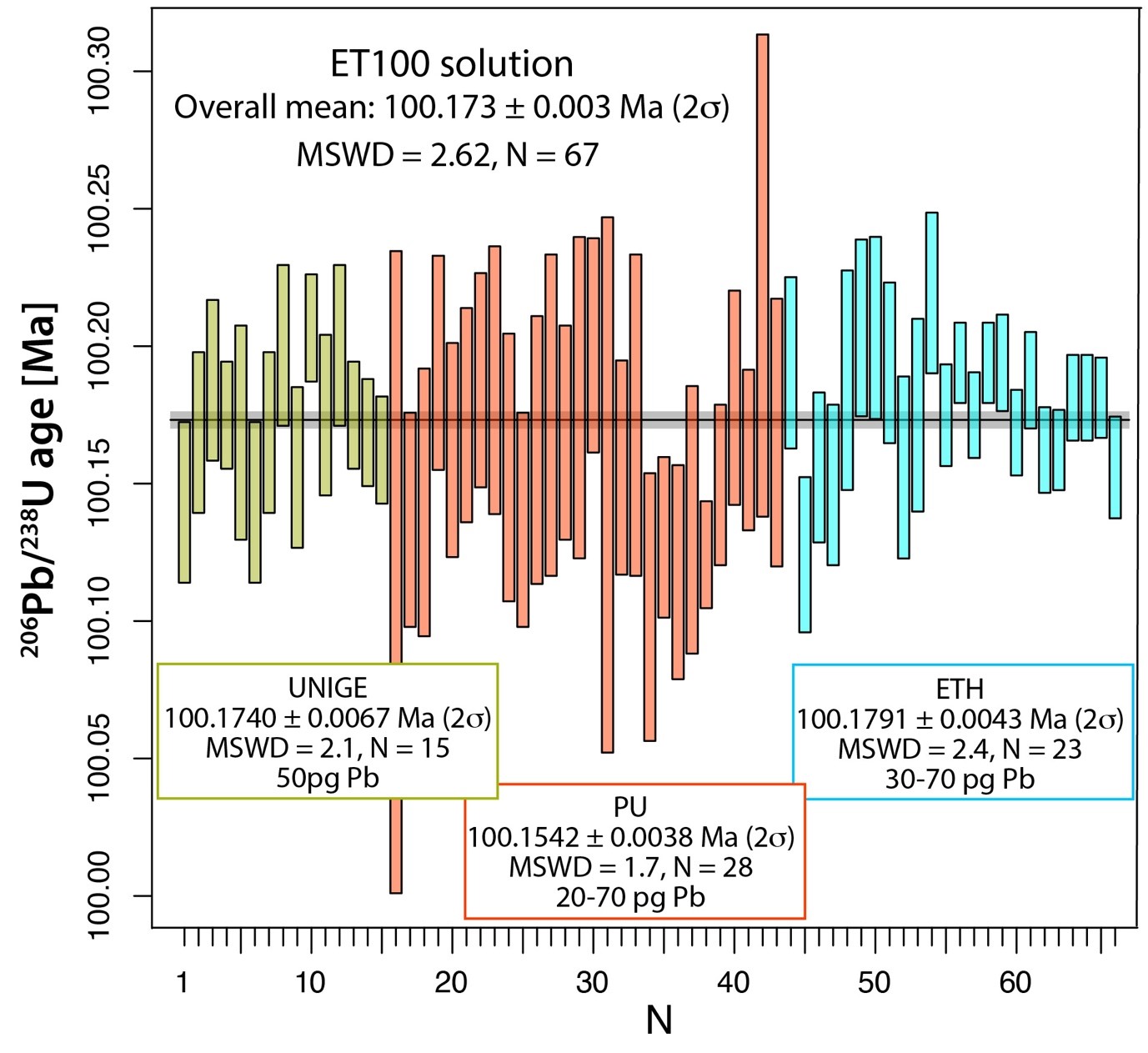
Apparent 206Pb/238U ages of ET100 synthetic solution from University of Geneva, Princeton University and ETH Zürich labs. For details on measurement conditions see text. Variable precision mainly results from differences in Pb*/Pbc of the individual aliquots due to variable amounts of ET100 solution analyzed (Schaltegger et al., 2021)
- Widmann P., Davies J.H.F.L. & Schaltegger U. (2019) Calibrating chemical abrasion: its effects on zircon crystal structure, chemical composition and U-Pb age. Chem. Geol., 511, 1-10, doi.org/10.1016/j.chemgeo.2019.02.02
-
Condon D., Schoene B., Mark Schmitz, Schaltegger U., Ickert R., Amelin Y., Augland L.E., Chamberlain K.R., Coleman D.S., Connelly J.N., Corfu F., Crowley J.L., Davies J.H.F.L., Denyszyn S.W., Eddy M.P., Heaman L.M., Huyskens M.H., Gaynor S.P., Kamo S., Kasbohm J., Keller C.B., MacLennan S.A., McLean N.M., Noble S., Ovtcharova M., Paul A., Ramezani J., Rioux M., Sahy D., Scoates J., Szymanowski D., Tapster S., Tichomirowa M., Wall C., Wotzlaw J.-F., Yang C., Yin Q.-Z. (2024) Recommendations for the Reporting and Interpretation of Isotope Dilution U-Pb Geochronological Information. GSA Bulletin, in press
- Schaltegger U., Ovtcharova M., Gaynor S.P., Davies J.H.F.L., Wotzlaw J.F., Greber N., Farina F., Szymanowski D. & Chelle-Michou C. (2021) Long-term repeatability and interlaboratory reproducibility of high-precision ID-TIMS U-Pb geochronology. J. Anal. Atom. Spectrom., 36, 1466-1477; doi.org/10.1039/D1JA00116G
- Schaltegger U., Ovtcharova M. & Schoene B. (2024) High-precision U-Pb geochronology of zircon: materials, methods and interpretations. In: Shellnutt G. et al., Methods and Applications for Geochronology, Elsevier, in press
High-precision U-Pb dating using chemical abrasion, isotope dilution, thermal ionization mass spectrometry (CA-ID-TIMS)
The analytical performance of zircon U-Pb dating using chemical-abrasion, isotope-dilution, thermal ionisation mass spectrometry needs to be continuously assessed to ensure 206Pb/238U zircon ages at the 0.001% level of uncertainty and accuracy. A lot of effort is done to measure synthetic (EARTHTIME ET100 solutions) and natural reference materials (GJ-1, TEMORA-2, Plesovice reference zircons) to assure precision, accuracy, repeatability and reproducibility of CA-ID-TIMS dating (Schaltegger et al., 2021). These efforts demonstrated that the two TIMS platforms (Triton of Thermo Scientific, and Phoenix of IsotopX) produce comparable results at highest precision. The optimal conditions of the procedure of chemical abrasion (thermal annealing prior to partial dissolution of decay-damaged zircon) were calibrated by Widmann et al. (2019). The optimal practices are summarized in the community paper by Condon et al. (2024). Underlying laboratory techniques are summarized in Schaltegger et al. (2024).
Timescales for the formation of Large Igneous Provinces and their intercalibration with periods of mass extinction
Dramatic environmental perturbation, climate overturn and mass extinctions in the geological past are considered to be caused by massive volcanic activity in Large Igneous Provinces (LIPS). We have previously demonstrated that in selected cases, catastrophic biotic change and dynamics and tempo of biotic post-extinction recovery can be dated at better than 100 ka uncertainty of the 206Pb/238U zircon date, e.g., in the Mesozoic. It is of primordial importance that the volcanic activity of LIPS associated with these biotic crises is dated at identical levels of precision and accuracy, in order to infer a causal relationship (Gaynor et al., 2023). Our work has revealed that zircon in mafic intrusive rocks of LIPS is not always a pure magmatic phase but derived from incorporation and melting of sedimentary material at the emplacement level (Gaynor et al, 2022). We have applied high-precision U-Pb dating of zircon (ZrSiO4) and baddeleyite (ZrO2) to volcanic rocks from Central Atlantic Magmatic Province (CAMP; Davies et al., 2019), to the Parana volcanic province (Rocha et al., 2020), the Karoo province in Lesotho/South Africa (Gaynor et al., 2022) and the Siberian Traps (Schaltegger et al., 2024; ongoing) through dating of sills, dykes and basaltic lavas.

Schematic model highlighting the process of LIP contamination at the emplacement level, from (A) initial LIP sill emplacement with diking and stoping of wallrock blocks, (B) incorporation of wallrock block melting during contact aureole development and finally (C) crystallization of the LIP sill with final thermogenic production with coeval crystallization of coarse-grained enclaves (Gaynor et al., 2023)
- Davies J.H.F.L., Marzoli A., Bertrand A., Youbi H., Ernesto N. & Schaltegger U. (2017) End-Triassic mass extinction started by intrusive CAMP activity. Nature Communications 8, 15596, doi:10.1038/ncomms15596
- Gaynor S.P., Davies J.H.F.L. & Schaltegger U. (2023) High precision geochronology of LIP intrusions: Records of magma-sediment interaction. Elements 19, 302-308, https://doi.org/10.2138/gselements.19.5.302
- Gaynor S.P., Svensen H., Polteau S. & Schaltegger U. (2022) Local melt contamination and global climate impact: Dating the emplacement of Karoo LIP sills into organic-rich shale. Earth Planet. Sci. Lett., 579, 117371, doi.org/10.1016/j.epsl.2022.117371
- Rocha C.B., Davies J.H.F.L., Janasi V.A. & Schaltegger U., Nardy A.J.R., Greber N., Luchetti A.C.F. & Polo L. (2020) Rapid eruption of silicic magmas from the Paraná Magmatic Province did not trigger the Valanginian Event. Geology, 48, 1174-1178, doi.org/10.1130/G47766.1
- Schaltegger U., Gaynor S.P., Paul A., Davies J.H.F.L., Svensen H. & Ramezani J. (2024) Challenges and insights from zircon and baddeleyite U-Pb ages and Hf isotope analyses of Karoo and Siberian LIP intrusive rocks. EGU General Assembly 2024, Vienna, EGU24-16856.
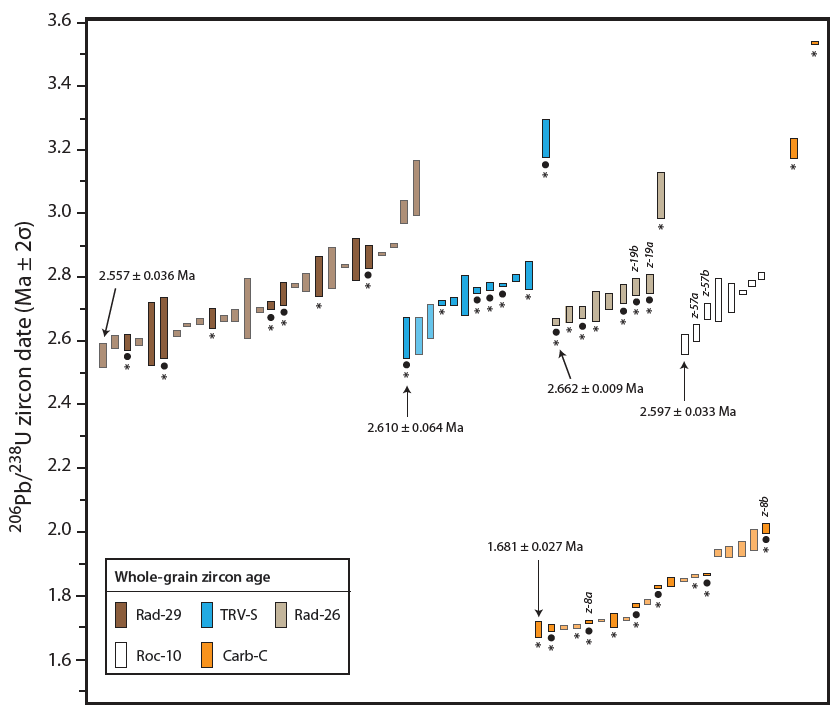
Rank-order plot of high-precision ID-TIMS 206Pb/238U zircon dates from three monzogranites of the Larderello-Travale intrusive system and for the Roccastrada rhyolite.. For each sample, the age of the youngest dated grains is indicated (Farina et al., 2018)
- Broderick C., Wotzlaw J.-F., U., Frick D., Gerdes A., Günther D. & Schaltegger U. (2015) Linking the thermal evolution of an upper crustal intrusion to its lower-crustal roots using zircon and titanite geochronology and geochemistry (Southern Adamello batholith, N. Italy). Contrib. Mineral. Petrol 170, 28
- Farina F., Dini A., Ovtcharova M., Davies J., Greber N.D., Bouvier A.-S., Baumgartner L., Ulyanov A. & Schaltegger U. (2018) Zircon petrochronology reveals the mechanism of crustal anatectic magma formation. Earth Planet. Sci. Lett., 495, 213-223
- Gaynor S.P., Smith T.M. & Schaltegger U. (2023) Tracing magmatic genesis and evolution through single crystals from successive super-eruptions from the Socorro Caldera Complex, USA. Earth Planet. Sci. Lett., in press, https://doi.org/10.1016/j.epsl.2023.118236
- Schaltegger U. & Davies J.H.F.L. (2017) Petrochronology of zircon and baddeleyite in igneous rocks: reconstructing magmatic processes at high temporal resolution. In: Reviews in Mineralogy and Geochemistry, vol 83, 297-328, doi:10.2138/rmg.2017.83.11
- Schaltegger U., Nowak A., Ulianov A., Fisher C.M., Gerdes A., Spikings R., Whitehouse M., Bindeman I.N., Brack P., Hanchar J., Duff J., Vervoort J.D., Sheldrake T., Caricchi L. & Müntener O. (2019) Zircon petrochronology and 40Ar-39Ar thermochronology of the Adamello intrusive suite, N-Italy: monitoring the growth and decay of an incrementally assembled magmatic system. J. Petrol. 60, 701-722
Timing and tempo of magmatism in the crust
Overwhelming evidence supports the notion that plutons are incrementally assembled by repeated magma injections and eventually build up batholiths over extended periods of time (Schaltegger et al., 2019). Timescales of pluton construction may vary from 104 to 106 years. Using high precision, chemical abrasion, isotope dilution thermal ionization mass spectrometry (CA-ID-TIMS) U-Pb zircon geochronology it is possible to resolve individual magma pulses and to track both the thermal and crystallization histories of magmatic systems at high temporal resolution (Farina et al., 2018).
During periods of repeated magma injections, temperature, crystal content and composition will fluctuate within magma batches, and conditions potentially alternate between zircon saturation and undersaturation, which will lead to intermittent periods of crystallization and resorption/partial dissolution. Following episodes of reheating and rejuvenation, zircon dates will record periods of enhanced zircon crystallization associated with cooling below the maximum temperature of zircon saturation. This is reflected by a distinct mode in U-Pb age distribution curves and translates into an increased proportion of zircon crystals of a similar age in individual magma batches (Broderick et al., 2015). High-precision CA-ID-TIMS dating techniques applied to zircon have the potential to resolve the periodicity of temperature fluctuations in a magmatic system at lower or intermediate crustal levels over the time interval the magma remained zircon saturated. However, such dates are obtained from whole zircon grains or grain fragments and are potentially integrated over complex and protracted growth histories (Schaltegger and Davies, 2017). Recent examples of case studies comprise Aamello (Schaltegger et al., 2019), Toscana (Farina et al., 2018), or Socorro volcanic complex, USA (Gaynor et al., 2023).
Calibration of the geological time scale by U-Pb dating of zircon in volcanic ash beds
The geological record is mainly preserved in sedimentary archives. Quantification of the Geological Time Scale in terms of precise absolute time by radioisotopic dating is needed to understand the timing of biotic and environmental change in the past and to infer the underlying mechanisms. Past and ongoing projects have investigated time periods in the Proterozoic and Phanerozoic by highest-precision U-Pb geochronology of zircon in volcanic ash beds, and tried to relate them to biodiversity events, impacts (Paul et al., 2024), extinction periods (Lena et al., 2019), changes of the magnetic field (Tonti-Filippini et al., 2024), or dramatic climatic and environmental overturns (Widmann et al., 2020).
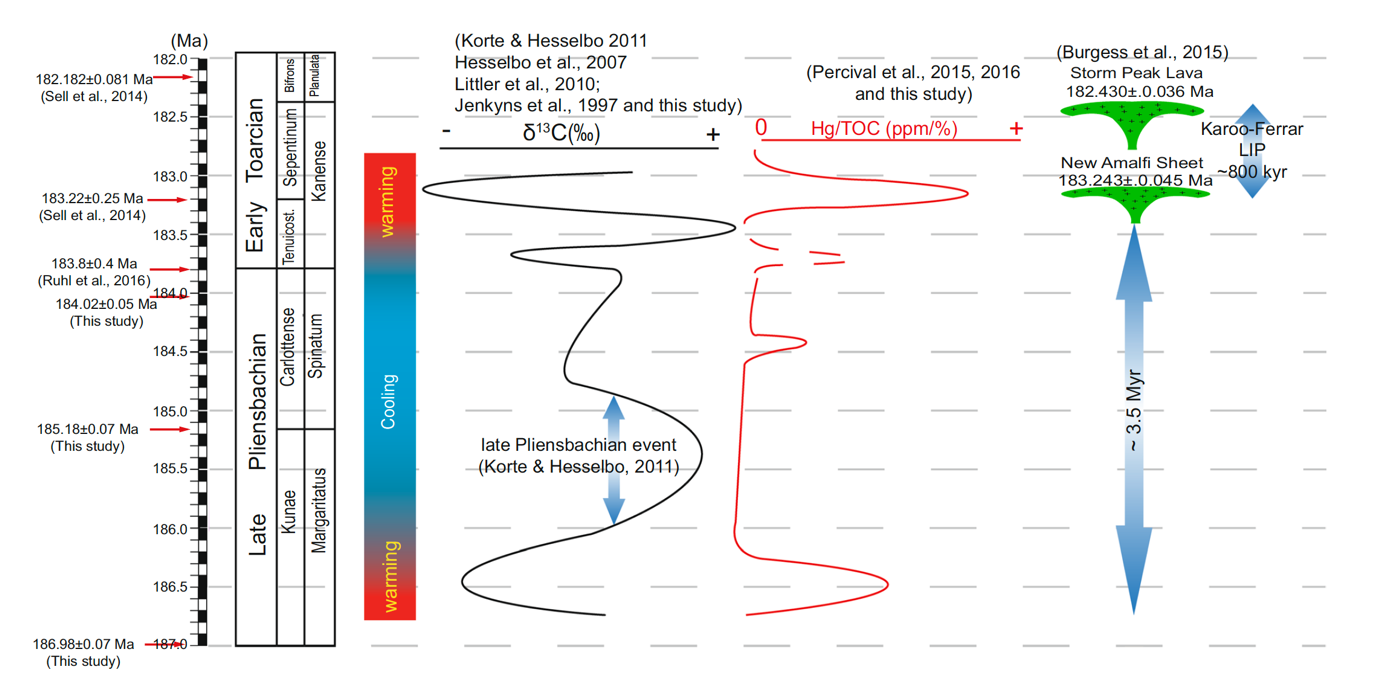
Temporal correlation between late Pliensbachian to the early Toarcian ammonite zones, carbon isotope variations, Hg/TOC anomalies, and the duration of the Karoo-Ferrar LIP (Lena et al., 2019)
- Lena L., Taylor D., Guex J., Bartolini A., Adatte Th., Van Acken D., Spangenberg J., Samankassou E., Vennemann T. & Schaltegger U. (2019) The driving mechanisms of the carbon cycle perturbations in the Late Pliensbachian (Early Jurassic). Sci. Rep. 9:18430; doi.org/10.1038/s41598-019-54593-1
- Paul A., Lindskog A. & Schaltegger U. Resolving the discrepancy between U–Pb age estimates for the ‘Likhall’ zircon bed, a key level in the Ordovician event stratigraphy and timescale. Submitted to Gchron, preprint at https://doi.org/10.5194/egusphere-2023-2597
- Tonti-Filippini J., Robert B., Muller E., Paul A., Dellefant F., Wack M., Meng J., Zhao X., Schaltegger U. & Gilder S.A. (2024) Neoproterozoic (Tonian) polar wander of South China: Paleomagnetism and ID-TIMS U-Pb geochronology of the Laoshanya Formation. In revision at J. Geophys. Res., in press, preprint at DOI: 10.22541/essoar.169504475.59949183/v1
- Widmann P., Bucher H., Leu M., Vennemann T., Bagherpour B., Schneebeli-Herrmann E., Goudemand N. & Schaltegger U. (2020) Dynamics of the largest carbon isotope excursion during the Early Triassic biotic recovery. Frontiers in Earth Science, https://doi.org/10.3389/feart.2020.00196
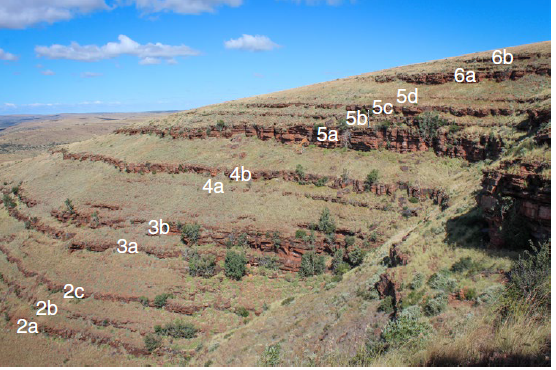
Rhythmic alternations in the weathering profile of the Kuruman BIF. The alternations show a consistent pattern between different sections in the Griqualand West basin (Lantink et al., 2019)
- Lantink M., Davies J., Hilgen F., Mason P. & Schaltegger U. (2019) Climate control on banded iron formations linked to orbital eccentricity. Nature Geoscience, doi.org/10.1038/s41561-019-0332-8
- Senger M.H., Davies J.H.F.L., Ovtcharova M., Beukes N.♱, Gumsley A., Gaynor S.P., Ulianov A., Mukwevho R. & Schaltegger U. (2023) Improving the chronostratigraphic framework of the Transvaal Supergroup (South Africa) through in-situ and high-precision geochronology. Precambrian Res. 392, 107070, https://doi.org/10.1016/j.precamres.2023.107070
- Widmann P., Davies J.H.F.L. & Schaltegger U. (2019) Calibrating chemical abrasion: its effects on zircon crystal structure, chemical composition and U-Pb age. Chem. Geol., 511, 1-10, doi.org/10.1016/j.chemgeo.2019.02.02
- Zakharov D.O., Bindeman I.N., Slabunov A.I., Ovtcharova M., Coble M.A., Serebryakov N.S. & Schaltegger U. (2017) Dating the Paleoproterozoic snowball Earth glaciations using contemporaneous subglacial hydrothermal systems. Geology 45, 667-670; doi:10.1130/G38759.1
High-precision temporal resolution of planetary processes in the Proterozoic and Archean
High-precision geochronology of Proterozoic to Archean zircon needs very thorough application of chemical abrasion techniques to mitigate decay-damage related Pb loss. Best results are achieved through stepwise leaching techniques that are controlled by chemical analysis and are developing a quantitative calibration of the conditions of the partial dissolution step by Raman spectroscopy (Widmann et al., 2019) to characterize and control the degree of decay damage and the efficiency of chemical abrasion.
High-precision techniques were also the clue for dating 2.45 to 2.22 Ga old glacial events in the Paleoproterozoic of the Belomorian Belt of northern Karelia, Russia (Zakharov et al. 2017). We have applied high-precision zircon dating to orbitally tuned strata of the Lower Proterozoic Kuruman Banded Iron Formation in S. Africa (Lantink et al., 2019). The cyclostratigraphic analysis revealed that the macrobanding of this BIF is controlled by Milankovitch forcing, more specifically through g4-g3 modulations of the 405 ky eccentricity cycle. Application of CA-ID-TIMS techniques to detrital zircon from early Proterozoic clastic sediments evidenced that analysis of non-treated zircon (usually using in-situ, spot-dating techniques) may produce temporal artefacts that are by 200 million years too young (Senger et al., 2023).
The state of the U-Pb system in zircon and baddeleyite under varying ambient physical and chemical conditions
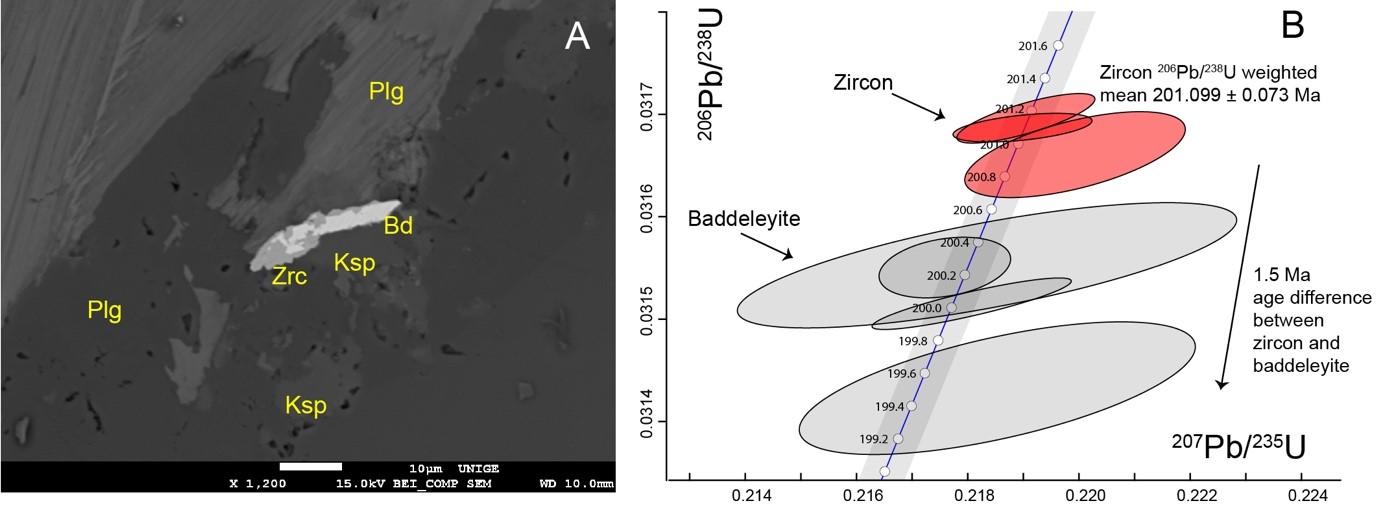
Relationship between baddeleyite and zircon in a CAMP basaltic dyke. A) BSE image from a thin section showing baddeleyite with zircon overgrowth, showing that baddeleyite crystallized before zircon, B) concordia diagram for the same sample, chemically braided zircon analyses are shaded red, and baddeleyite without chemical abrasion is shaded grey. Note that the zircon analyses overlap within uncertainty and the baddeleyite ages are all younger, but still concordant (Schaltegger and Davies, 2017)
- Davies J.H.F.L., Seydoux-Guillaume A.-M. & Schaltegger U. (2017) Structural and chemical characterization of baddeleyite with implications for U-Pb geochronology. Goldschmidt Conference, August 13-18, 2017, Paris
- Schaltegger U. & Davies J.H.F.L. (2017) Petrochronology of zircon and baddeleyite in igneous rocks: reconstructing magmatic processes at high temporal resolution. In: Reviews in Mineralogy and Geochemistry, vol 83, 297-328, doi:10.2138/rmg.2017.83.11
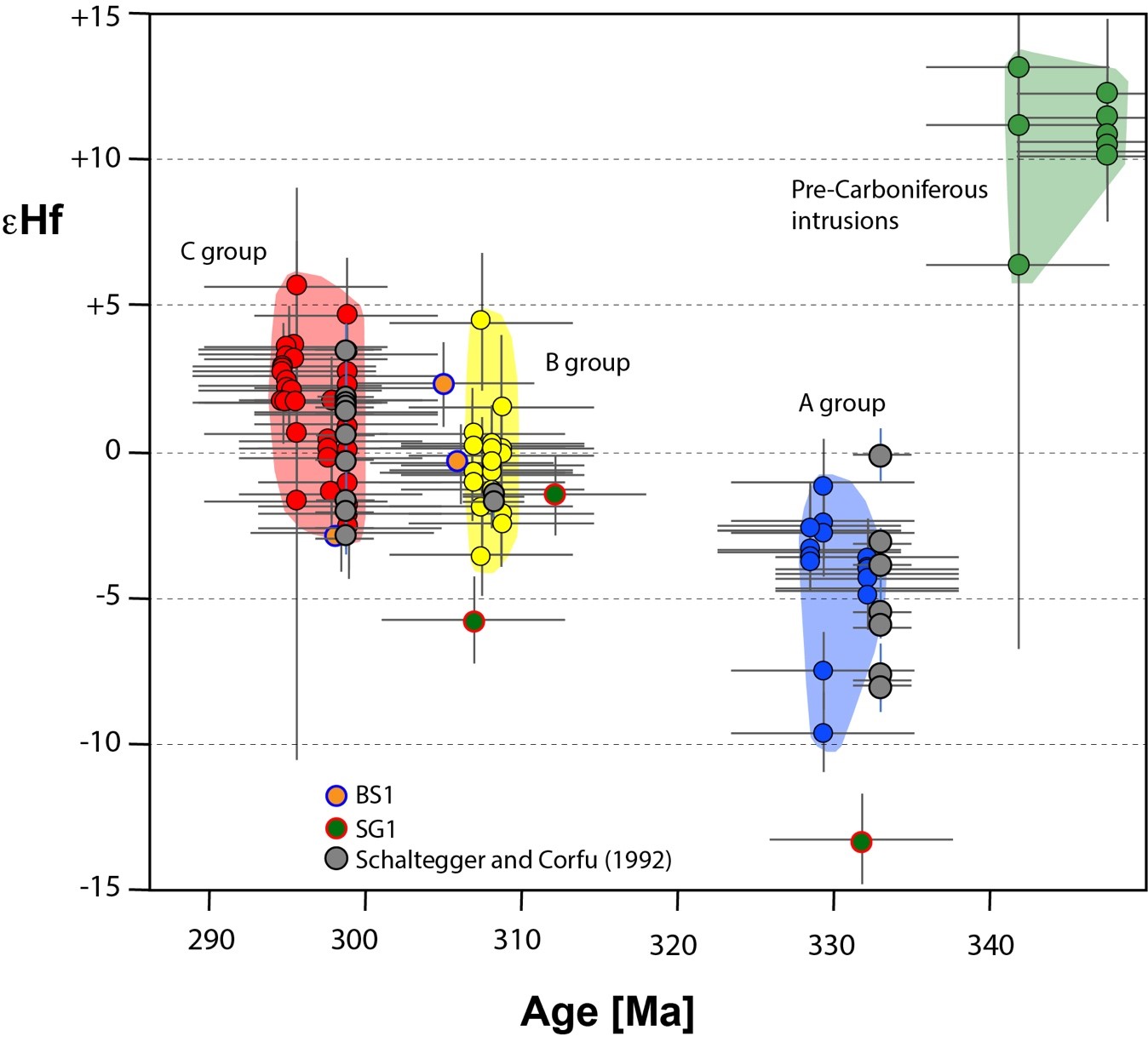
Initial Hf isotope composition of zircon from the four intrusive pulses of the Aar batholith, determined by LA-MC-ICP-MS (Ruiz et al., 2022)
- Gaynor S.P., Ruiz M., & Schaltegger U. (2022) The importance of high precision in the evaluation of zircon U-Pb ages. Chem. Geol., 603, 120913, doi.org/10.1016/j.chemgeo.2022.120913
- Ruiz M., Schaltegger U., Gaynor S.P., Chiaradia M., Abrecht J., Gisler C., Giovanoli F. & Wiederkehr M. (2022) Reassessing the intrusive tempo and magma genesis of the late Variscan Aar batholith: U-Pb geochronology, trace element and initial Hf isotope composition of zircon. Swiss J. Geosci., 115, 20, doi.org/10.1186/s00015-022-00420-1
- Von Raumer J., Bussy F., Schaltegger U. & Stampfli G.M. (2013) Pre-Mesozoic Alpine basements – their place in the European Paleozoic framework. GSA Bull. 125, 89-108
